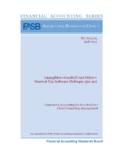Transcription of US GAAP versus IFRS - ey.com
1 US GAAP versus IFRS The basics December 2011 !@# US GAAP versus IFRS The basics 1 Introduction .. 2 financial statement 4 Interim financial reporting .. 6 Consolidation, joint venture accounting and equity method investees .. 7 Business combinations .. 11 Inventory .. 13 Long-lived assets .. 14 Intangible assets .. 16 Impairment of long-lived assets, goodwill and intangible assets .. 18 financial instruments .. 20 Foreign currency matters .. 28 Leases .. 30 Income taxes .. 33 Provisions and contingencies .. 35 Revenue 37 Share-based payments.
2 39 Employee benefits other than share-based payments .. 41 Earnings per share .. 44 Segment reporting .. 45 Subsequent events .. 46 Related parties .. 48 Appendix The evolution of IFRS .. 49 Table of contents Introduction US GAAP versus IFRS The basics 2 Convergence continued to be a high priority on the agendas of both the US financial accounting standards board (FASB) and the International accounting standards board (IASB) (collectively, the Boards) in 2011. However, the convergence process is designed to address only the most significant differences and/or areas that the Boards have identified as having the greatest need for improvement.
3 While the converged standards will be more similar, differences will continue to exist between US GAAP as promulgated by the FASB and International financial Reporting standards (IFRS) as promulgated by the IASB. In this guide, we provide an overview by accounting area of where the standards are similar and where differences exist. We believe that any discussion of this topic should not lose sight of the fact that the two sets of standards are generally more alike than different for most commonly encountered transactions, with IFRS being largely, but not entirely, grounded in the same basic principles as US GAAP.
4 The general principles and conceptual framework are often the same or similar in both sets of standards , leading to similar accounting results. The existence of any differences and their materiality to an entity s financial statements depends on a variety of specific factors, including the nature of the entity, the detail of the transactions, interpretation of the more general IFRS principles, industry practices and accounting policy elections where US GAAP and IFRS offer a choice. This guide focuses on differences most commonly found in present practice and, when applicable, provides an overview of how and when those differences are expected to converge.
5 Will the differences ever be eliminated? The FASB and the IASB have made significant strides toward their stated goal of converging US GAAP and IFRS, but they have yet to finalize three of the priority projects they identified in their 2008 Memorandum of Understanding: financial instruments, revenue recognition and leases. The Boards are also working on other major joint projects, including one involving insurance contracts. However, convergence efforts alone will not eliminate all differences between US GAAP and IFRS.
6 In fact, differences continue to exist in standards for which convergence efforts already have been completed, and for which no additional convergence work is planned. The US Securities and Exchange Commission (SEC) has for many years been committed to the goal of a single set of high-quality global accounting standards . In this regard, the SEC has strongly supported the efforts of the FASB and the IASB to align their standards , noting that execution of the convergence projects and the results of that work are important as the staff considers the issue of incorporation of IFRS.
7 The SEC had been expected to decide whether and, if so, how to incorporate IFRS into the US financial reporting system in 2011, but delayed that decision because the Boards convergence projects were not yet complete and the SEC staff had not yet produced a final report on its work plan to prepare the Commission for a decision. Support nevertheless seems to be growing for an approach that would retain US GAAP but use IFRS as a basis for future standards . That approach would be similar to the one outlined in a May 2011 SEC Staff Paper.
8 Introduction Introduction US GAAP versus IFRS The basics 3 At the December 2011 AICPA conference, SEC Chief Accountant James Kroeker emphasized that the speed of convergence efforts and potential incorporation of IFRS into the US financial reporting system was less important than the quality of standard setting and/or the framework of incorporation. While no decision had been made when we issued this publication, we recommend that stakeholders continue to monitor the SEC s deliberations and, as appropriate, provide feedback to the SEC staff as it prepares its final report and recommendations for the Commission.
9 We believe that the success of a uniform set of global accounting standards also will depend on the willingness of national regulators and industry groups to cooperate. Local interpretations of IFRS and guidance that provides exceptions to IFRS principles would threaten the achievement of international harmonization. Consistency in interpretation, application and regulation of IFRS is crucial to achieving a single set of high-quality global standards . Key updates This publication has been updated for key developments through December 2011.
10 Our analysis generally reflects guidance finalized by the FASB and the IASB before 31 December 2011, even if those standards are effective in subsequent periods. However, we have not included final standards for which the standard setters have delayed effective dates, such as IFRS 9, which is not effective for IFRS reporters until 2015, except in our discussion of convergence. We will continue to update this publication periodically for new developments. * * * * * The Ernst & Young US GAAP-IFRS Differences Identifier Tool provides a more in-depth review of differences between US GAAP and IFRS.















